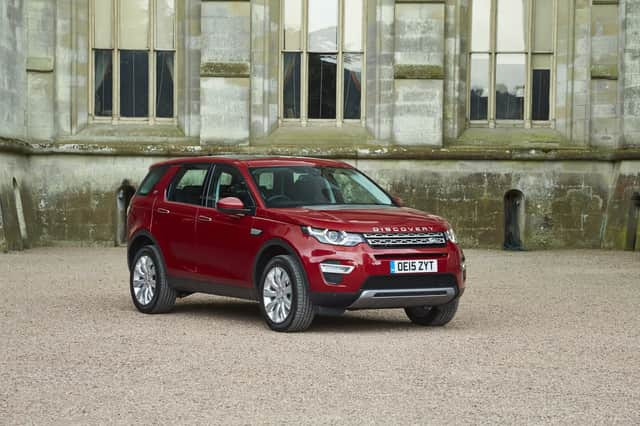REVIEW: Land Rover Discovery Sport


Well, in the case of the new Discovery Sport an additional two seats and a smarter infotainment system are two areas where Land Rover have decided to offer a little bit extra.
Taking over where the Freelander left off, after 17 years of production, the new offering aims to align itself more closely with the brand’s more premium offerings, hence the fusion of two existing vehicles with an established reputation.
Advertisement
Hide AdAdvertisement
Hide AdFor those who like the face of the Evoque, the newcomer will be hailed as a success before they have set foot inside.
Sharing a very similar, slim-line honeycombed grille and light clusters, chunky front bumper and clamshell bonnet of the smaller SUV, it might be heard to tell them apart from head-on.
Further back the two are clearly distinguishable.
At less than 4.6m long, the Discovery Sport has a smaller footprint than most seven-seat SUVs, but is considerably longer than the square-standing Evoque.
A rising belt line ends with quite a tall, tapered rear end which looks fairly streamlined and dynamic.
Advertisement
Hide AdAdvertisement
Hide AdCircular rear light and daytime running light themes add the the distinctive styling of Land Rover’s new introduction.
Prices start at £30,695 for the entry-level SE TD4 and rise to £43,000 for the HSE Luxury and the version I got to grips with during a week-long appraisal was the mid-range SD4 SE Tech, priced at £33,895.
Part-leather trim, 18-inch alloys, fog lamps and a host of colour-coded trim are standard styling features (a panoramic sunroof was a £950 option).
In terms of hardware climate control, cruise control, a powered boot lid, heated front seats and windscreen, automatic lighting and wipers, Bluetooth phone connectivity, DAB radio and that new eight-inch touchscreen sat nav system are all standard fayre.
Advertisement
Hide AdAdvertisement
Hide AdMy test car came with a six-speed manual gearbox, rather than the optional nine-speed automatic, and came with one of the last of Land Rover’s 2.2-litre turbodiesel engines carried over from the Freelander.
New Inginium engines, which offer greater eco credentials, are now being slotted into Discovery Sport’s leaving the production line at Halewood, near Liverpool.
The 2.2-litre SD4 unit claimed fuel economy of 46mpg with accompanying CO2 emissions of 162g/km, while a dash to 60mph should have taken 9.8 seconds on the way to a 118mph top speed.
After making a keyless entry and starting the engine with a push button the SD4 unit sounds a little industrial, if not strangely befitting of such a rugged off-road tool.
Advertisement
Hide AdAdvertisement
Hide AdRugged does not really spring to mind when you feel the stability control and toque control systems doing their thing out on the road.
There’s little disguising the Discovery Sport’s mass — it feels like a large, fairly heavy vehicle — but the effect of inside wheels braking them,selves through a corner to tie the chassis onto a chosen path through a corner does bestow it with a degree of unexpected accuracy and mid-corner traction.
In the past I found that the Freelander was a decent steer, and particularly wieldy in front-wheel-drive form, and the Discovery Sport has a similarly languid composure about it.
Passengers will find reasonable comfort, meanwhile, thanks to a ride that's not overly firm.
Advertisement
Hide AdAdvertisement
Hide AdProgress is fairly brisk too, with a determined prod of the throttle returning the rousing effects of 187bhp and 310lb.ft. of torque.
My only real gripe came in the form of repeated flat-spots as the engine accelerated through 1,200 to 1,350rpm. Hopefully this will not be an issue for Inginium-engined versions.
Some of the biggest changes to the Discovery Sport over the Freelander are in styling and the interior is as different to the older vehicle as the exterior, with a more Evoque-inspired feel now in place.
Strong vertical and horizontal lines give a straightforward, no-nonsense feel with well placed touches of aluminium emphasising a feeling of structural strength in key areas.
Advertisement
Hide AdAdvertisement
Hide AdSome of the plastics are not the most visually appealing — some large dull-looking buttons, for example — but overall it is functional and robust.
Land Rover’s touchscreen sat nav and infotainment system, dubbed InControl, almost looks a little too slick by comparison.
Hi-res graphics mimic the appearance and functionality of an ipad or tablet and can mirror the apps available on the driver’s smartphone, if desired.
A fusion of the rugged, off-road ability of Land Rovers of old and the lifestyle-savvy premium offerings of recent years, the Discovery Sport is a more well-rounded and modern proposition than the Freelander.
Advertisement
Hide AdAdvertisement
Hide AdElements of the interior lack the finesse of some German rivals and it not the most dynamic steer among SUVs at this price, but boasting a third row of seats capable of accommodating two kids makes it a more flexible proposition.
Its appeal depends where, exactly, you want your value added.
Land Rover Discovery Sport SD4 SE Tech
Engine: 2.2-litre, four-cylinder, turbodiesel
Power: 187bhp and 310lb.ft. of torque
Performance: 0-62mph in 9.8 seconds and 118mph
Economy: 46mpg (combined)
CO2 emissions: 162g/km
Price: £33,895